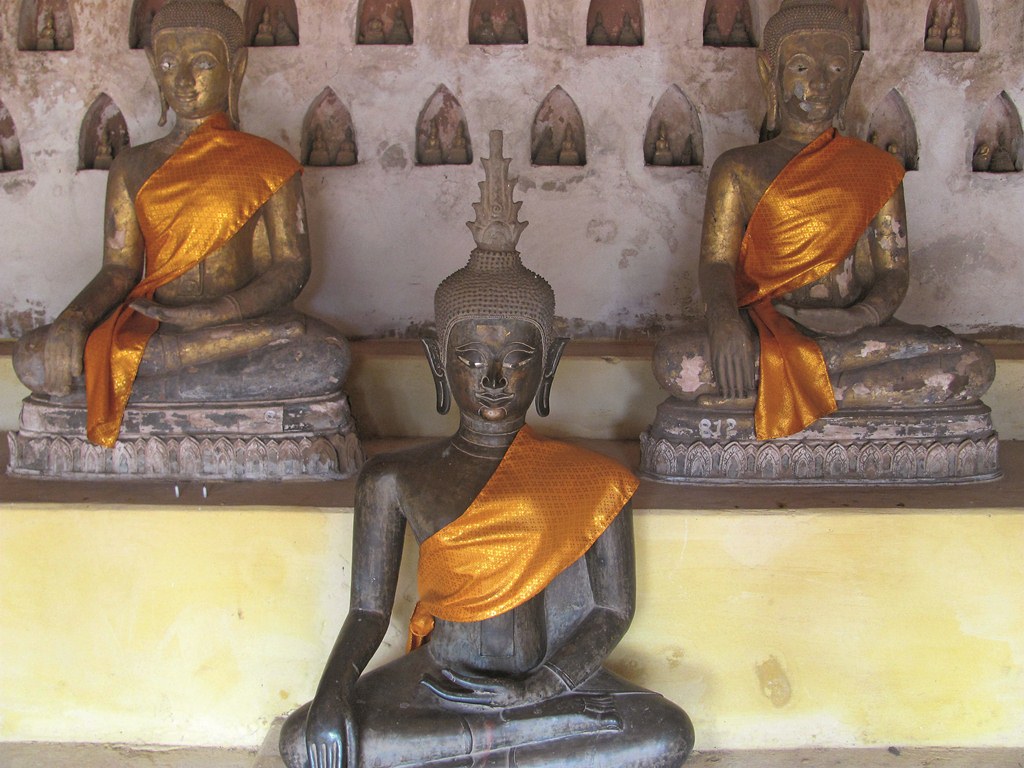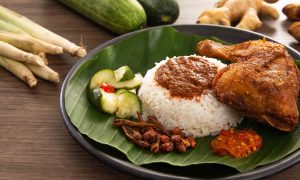Written by Petra O’ Neill
Perhaps fittingly in a land where very few things move at a hectic pace, Petra O’Neill takes the slow route across Laos.
Whether it was my eyebrows that had been left unattended for several weeks or some other curiosity, the Lao woman seated on the bus beside me intently scrutinised my face for the better part of six hours, all the while screwing up her nose in an expression suggestive of disapproval. The VIP bus prominently displayed on posters across the small city of Pakse had morphed into a local bus with hard seats which, when all were occupied, led to the production of plastic stools forming a successive line of passengers along the aisle. Periodically, women would board, squeezing themselves past the cramped passengers and the veritable mobile feast they were selling, too: a spread of bottled soft drinks, sliced tropical fruit, sticky rice, and BBQ chicken pressed between bamboo sticks.
I never expected that a bus journey from Pakse in southern Laos to Vientiane, some 685 kilometres north, would take only 10 hours as the posters had indicated, so I broke the journey midway at Savannakhet, a city on the Mekong and one of the major crossroads of Southeast Asia, with traffic bound for Hanoi in one direction and Bangkok in the other.
Here I met an elderly Frenchman riding his bicycle who directed me to my guesthouse, the website having conveyed somewhat rather enhanced images as the interior had peeling paint and drips from the ceiling collecting into a bucket. Savannakhet is a sleepy, languid city with honey-coloured French colonial villas, their crumbling façades betraying their age. I gathered together market provisions of rambutans, bananas, and baguettes for the next day’s journey and, faced with a restaurant menu I was unable to decipher, settled on a tasty bowl of French fries.
Next morning, I set off by local bus with only two other passengers, a student and a young engineer who worked for an Australian company. Stopping for anyone who waved, the bus was soon fully loaded with provisions so heavy the axle broke. A rudimentary repair somehow got us going again, with motor bikes, farm equipment and furniture strapped on top, and bags of sand, luggage, and briquettes underneath. The scenery was flat, unlike the mountainous terrain of the north with fields of rice and corn punctuated by small villages. After an 11-hour bus ride, I was beyond relieved to arrive at the delightful Mali Namphu Guesthouse and was shown to my room overlooking a lush courtyard.
Vientiane
Vientiane, the capital of Laos, is only beginning to awaken to the possibilities of tourism, and while it offers travellers much to see, the first place I always head for is the Joma Bakery for a delicious cheese and salad sandwich on rye bread, before strolling on the promenade alongside the Mekong River, a place where locals gather to exercise in the early evenings.
The following day, I visited Wat Sisaket, dating back to 1818 with thousands of Buddha figures of silver, wood, and bronze (some remaining from the 15th century), and minutely detailed murals, the only Vientiane temple not destroyed by the Siamese when they invaded Laos in 1828. Opposite is another notable temple, Haw Pha Kaew, dating from 1565, that was badly damaged, then later rebuilt, and is now a museum for religious objects. Ancient Buddhas dating from the sixth to ninth centuries of stone and bronze line the temple exterior, and the renowned Emerald Buddha, sadly now found in the royal compound in Bangkok, was once housed here. Nearby, the Presidential Palace is a vast flamboyant chateau used for ceremonial occasions that was built in 1925 for the French Governor.
A city with no high-rise buildings, Vientiane is exceptionally laid-back, providing a pleasant lifestyle for its inhabitants including several thousand international aid workers. Many cafés and restaurants have been established in recent years by expatriates. Vientiane has wide, tree-lined avenues and imposing French colonial architecture interspersed with monuments, Chinese shop houses and gracious Buddhist temples, a city that is ideal for exploring on foot.
The most striking example of the French presence is the Patuxai, or victory gate, a smaller version of the Arc de Triomphe. Completed in 1969, it features distinctly Laotian ornamentation made from cement that American funds had earmarked for building a new airport. The French left other urban markers, including the Settha Palace
Hotel built in the 1930s as an administration building that opened as a luxury hotel in 1999, and Place Namphou, a large fountain encircled by European restaurants. Lingering cultural influences include locally grown coffee and baguettes served by street vendors filled with pâté, but adapted to suit with Lao-style vegetables and dressings. The best restaurant for traditional Lao cuisine is Makphet in a lovely old colonial building that provides training for disadvantaged youth.
While travellers head for the orderly Talat Sao Market, with embroidered silks in every form, locals head for the fresh produce market, Talat Khua Din. There are also several high-end boutiques along Nokeo Kumman with fine hand-woven silk scarves, silver jewellery, and wooden carvings.
The most venerated place in Vientiane is Pha That Luang, a gold-coloured chedi with an elongated spire that is said to contain a relic of the Buddha and may date all the way back to the third century. It was also badly damaged, pillaged, and abandoned for almost a century. Since being restored, however, it has remained a pilgrimage site for Buddhists from across Asia.
Change is coming to Laos, but only incrementally compared with the turbo-charged pace of development beyond its borders in Thailand, Vietnam, and China, and while services and infrastructure are basic in many parts of the country, any hardship experienced by the traveller is duly compensated. The Mekong and its tributaries provide life support for much of the country, and several days later, as I crossed the Friendship Bridge into Thailand, I thought of the conversation I’d had in Vientiane with a man named John while enjoying a delicious mango, banana, and pineapple shake. At 73, he had worked for 30 years for the United Nations, undertaking assignments across Asia and Africa. Unintentionally, he had decided that for him, Vientiane was now home. Melbourne, Australia is too busy and bitterly cold in winter, he said, while here it is peaceful. And with that he hopped on his bicycle and rode off into the night.
TRAVEL NOTEBOOK
Getting There
Several airlines fly from Malaysia to Vientiane, including AirAsia.
Getting Around
Vientiane’s city centre is compact and eminently walk-able. Tuk tuks and taxis are plentiful. Long-distance public buses are challenging. Preferable are the mini buses catering for travellers that operate in parts of Laos.
Where to Stay
The Mali Namphu Guesthouse is charming, centrally located, and moderately priced. Request a deluxe room facing the courtyard (malinamphu.com). The luxurious Settha Palace Hotel has spacious suites and a club-like ambiance. (setthapalace.com)
Where to Eat
Many cafés and restaurants have been established in recent years – quite a few by expatriates – including Joma that has great soups, salads, and sandwiches. Coffee shops offer free Wi-Fi with Common Grounds Café and Bakery one of the best. Makpet serves flavourful traditional Lao cuisine in lovely surroundings.
Where to Shop
Saoban works with traditional artisans to preserve and promote village crafts under fair trade principles (saobancrafts.com). Be careful when choosing silk such as at Talat Sao Market to ensure the fibre is silk and hand-woven.
Insider’s Tip
English is not widely spoken, so be patient. A visa is required for most nationals for entry into Laos.
Read more:
Source: The Expat magazine October 2015
"ExpatGo welcomes and encourages comments, input, and divergent opinions. However, we kindly request that you use suitable language in your comments, and refrain from any sort of personal attack, hate speech, or disparaging rhetoric. Comments not in line with this are subject to removal from the site. "

























Perhaps the woman on the bus DID dsapprove of your presence on the bus, and by extension, in her country?
Laos is definitly a very nice place. The best time of the year to go there is coming up. December and January are the best months. The weather is cooler and it is the dry season, usually there is no rain.
Nice article !